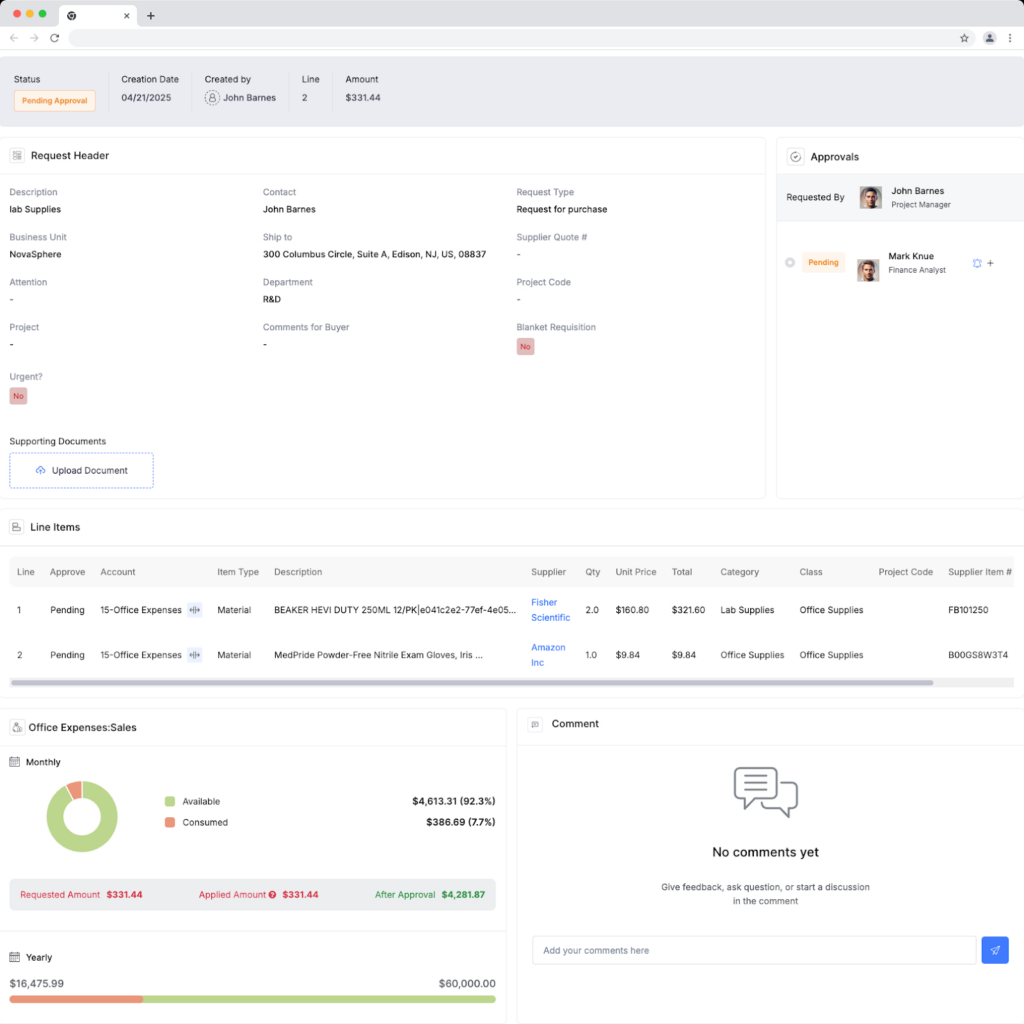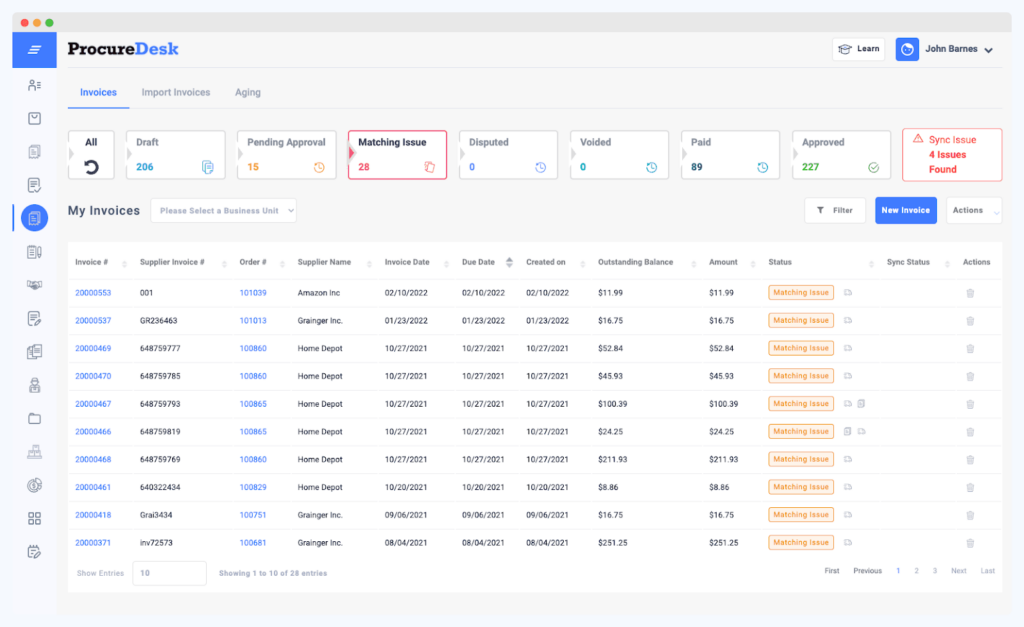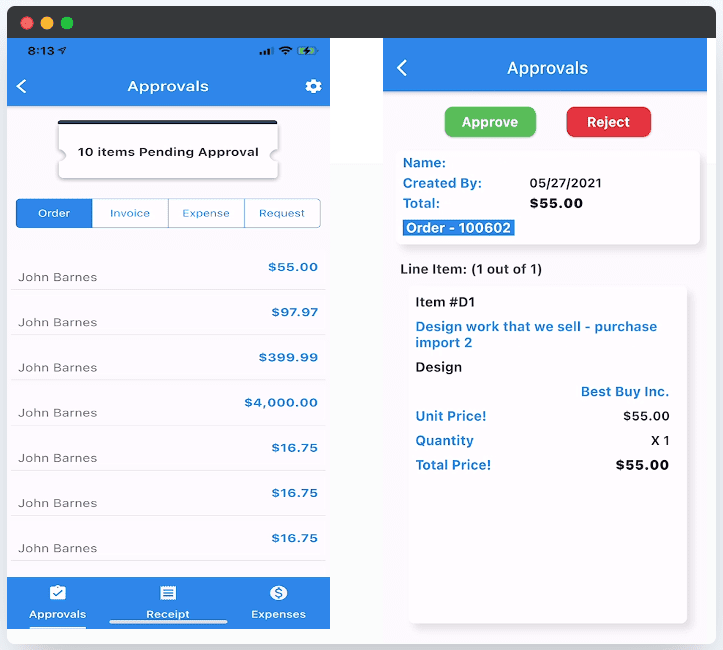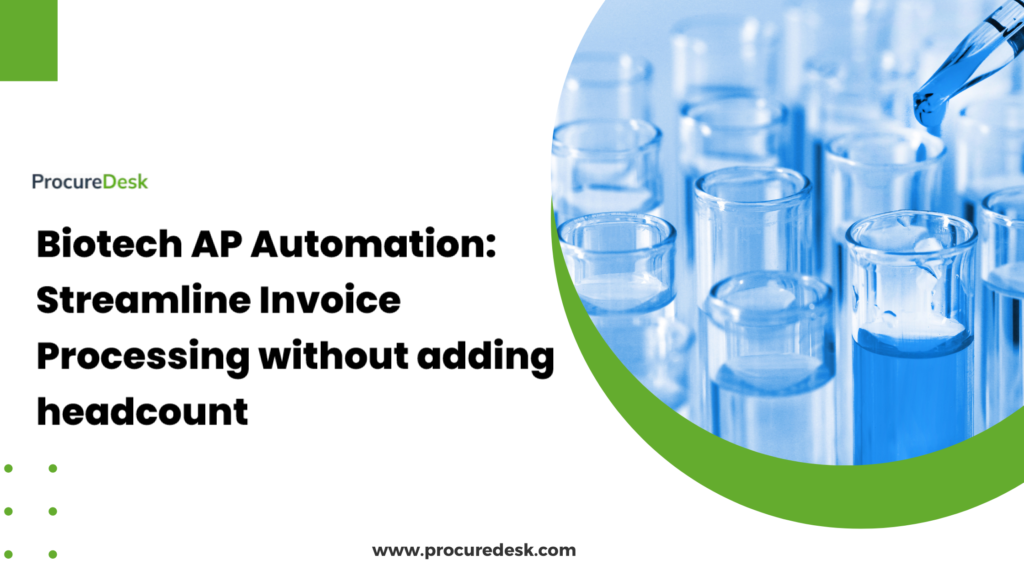Biotech companies waste up to 15 hours per week on manual invoice processing. For growing life sciences organizations, this inefficiency isn’t just frustrating—it’s draining valuable resources that could be directed toward research advancement and extending cash runway.
The problem? Standard AP automation solutions weren’t built with biotech’s unique challenges in mind. Lab supply invoices have specific compliance requirements, complex approval chains, and specialized integration needs that general solutions simply don’t address.
This guide outlines how biotech and life sciences companies can transform their payables process with specialized AP automation, cutting processing time by up to 60% while strengthening compliance and financial visibility. You’ll discover how AP automation software capabilities, such as 3-way matching, touchless e-invoicing, and deep vendor integrations, can eliminate manual data entry and create a seamless finance ecosystem tailored to biotech’s unique needs.
Why Biotech Companies Need a Complete Procure-to-Pay System
Biotech companies face unique challenges that require an end-to-end solution covering the entire procurement-to-payment process:
- High-volume lab supply purchasing: Managing hundreds of monthly invoices from specialized scientific suppliers
- Complex approval requirements: Navigating multi-departmental approvals across research, compliance, and finance teams
- Regulatory compliance demands: Maintaining detailed documentation for audit trails and industry-specific requirements
- Cash runway visibility: Needing real-time insight into spending to maximize limited research funding
- Integration requirements: Connecting with specialized biotech accounting systems like QuickBooks, Netsuite, and Sage Intacct.
- Multi-channel invoice processing: Handling invoices arriving through diverse channels (email, EDI, paper, vendor portals)
- Documentation management: Storing vendor documents for regulatory compliance and grant reporting
Without a specialized end-to-end solution like ProcureDesk, biotech finance teams waste valuable hours on manual requisition approvals, purchase order creation, and invoice processing. This inefficiency not only burdens staff but creates dangerous visibility gaps that can affect compliance, cash flow management, and strategic decision-making.
ProcureDesk’s comprehensive procure-to-pay solution was designed specifically to solve these biotech accounts payable challenges. Our platform streamlines the entire purchase-to-payment process—from requisitions and purchase orders to punchout catalogs and invoice processing—in one integrated system.
If you’d like to know more about ProcureDesk, read on or feel free to schedule a time with one of our product specialists.
How ProcureDesk’s Complete Procure-to-Pay Platform Transforms Biotech Financial Operations
ProcureDesk offers a comprehensive end-to-end solution specifically designed for the unique needs of biotech and life sciences companies, covering the entire purchasing lifecycle and automation of internal controls:
Requisition and Purchase Order Management
Lab managers who manage biotech procurement often experience frustration in managing lab purchases through spreadsheets and emails. The manual task is cumbersome and prone to errors.
Here is how our AP automation system resolves this:
When a researcher needs to order critical reagents or equipment, they simply log into our intuitive portal. Instead of generic forms, they’ll access customized request templates specifically designed for biotech purchases. These smart forms automatically capture all the information your finance team needs – from chart of accounts to grant allocations and project codes. No more back-and-forth emails asking for missing information that delays critical research.
Here is an example of a purchase request form:

Once submitted, our system takes over. Rather than manually forwarding emails to various stakeholders, our intelligent approval workflows automatically route the request to the right people based on your organization’s unique requirements. Whether approval depends on department, dollar amount, or even specific projects, the system ensures the right eyes review each purchase while tracking every step for compliance.
You can approve from email, using the mobile app, or using the web application.
After final approval, there’s no need for someone to manually create purchase orders in a separate system or track them in yet another spreadsheet. The platform instantly generates professional electronic POs and sends them directly to your vendors. Your team can finally say goodbye to those error-prone manual PO processes that consume so much valuable time.
Throughout the entire process, everyone maintains complete visibility. Lab managers, researchers, and finance teams can track orders in real-time through a centralized dashboard. No more wondering “what happened to my order?” or “when will these critical reagents arrive?” Everyone sees exactly where things stand, from request to delivery, all in one place.
This streamlined approach doesn’t just save time—it transforms how your biotech organization manages spending, ensures compliance, and ultimately extends your runway by eliminating wasteful processes. Would you like to see how this might look with your specific approval workflows?
Extensive Punchout Catalog Capabilities
When you’re managing a biotech lab, you need fast access to trusted vendors without the hassle of juggling multiple websites and systems. Our platform connects you directly with your preferred lab suppliers through our comprehensive integration network.
You can shop from over 150 vendor punchouts, including industry leaders like Thermo Fisher Scientific and VWR, all without leaving our system. Researchers simply browse and select items on the familiar vendor websites they already know, maintaining the same shopping experience they’re comfortable with.
What makes this truly powerful is the seamless cart transfer, which avoids human error. When your team finishes selecting items, their entire cart automatically syncs into your procurement system with perfect accuracy – no manual data entry that could introduce costly errors or delays. Plus, all your specially negotiated contract pricing is automatically applied at checkout, ensuring you always receive your authorized discounts without having to remember complex pricing agreements.
The following is an example of using a punchout to access the website:

Advanced E-Invoicing for Touchless Processing
Our accounts payable automation software transforms your invoice handling process. Instead of drowning in paperwork and manual data entry, your team can focus on strategic financial decisions while our system handles the routine work.
With our vendor e-invoicing portal, suppliers submit their invoices directly into your system in digital format—no more paper invoices getting lost in transit or sitting on someone’s desk. This touchless approach ensures timely processing and helps you maintain positive vendor relationships by consistently meeting payment terms.
We automate invoice capture using our advanced OCR (Optical Character Recognition) technology, which extracts all critical invoice data from supplier invoices.
This includes vendor information, line items, amounts, and due dates. The system validates this information in real-time, eliminating human error from manual entry that can cause payment delays or mistakes.
What really sets our solution apart is the flexible invoice approval routing. You can design custom approval workflows that match your organization’s structure, whether approvals should flow by department, project, dollar threshold, or any combination of factors. Managers can approve invoices from anywhere, even on mobile devices, preventing bottlenecks when key approvers are traveling.
Our intelligent matching engine automatically links invoices to their corresponding purchase orders and receiving documents, enabling complete 2-way or 3-way matching without manual intervention. When discrepancies arise—like price variances or quantity mismatches—the system automatically routes exceptions to the right personnel for resolution.
Throughout the process, every action is documented in a comprehensive electronic audit trail, ensuring you meet compliance requirements and have complete transparency for audits.
The invoice status is accessible through a central dashboard where you can monitor the status of every invoice in your system and maintain control over your cash flow.

ProcureDesk AP automation software fully automates the vendor payments process along with comprehensive invoice management capabilities.
Accounting and ERP integration
Our platform seamlessly connects with your existing financial ecosystem, eliminating data silos and manual transfers. ProcureDesk offers direct, two-way integration with major accounting systems, including QuickBooks, NetSuite, Sage Intacct, Microsoft Business Central, and Xero.
These connections ensure that purchase orders, invoices, and payment information flow automatically between systems without manual intervention. We also integrate with biotech-specific ERP solutions, maintaining your specialized workflows rather than forcing changes.
Your vendor relationships are enhanced through our catalog integrations, connecting directly to supplier ordering systems and inventory management platforms. For unique requirements, our open API architecture provides flexibility for custom connections to any biotech-specific systems your organization relies on.
Mobile Accessibility
Maintain continuity even when key personnel are in the lab or traveling:
- Mobile apps for iOS and Android
- Email-based approval options
- Delegation capabilities for when approvers are unavailable
- Real-time notifications for pending approvals
- Document access from any device

Gain real-time cash flow visibility
Gain insights crucial for biotech financial management:
Open Order Reports give your biotech finance team the real-time cash flow insights needed for strategic decision-making without waiting for month-end close.
With our comprehensive dashboard, you have real-time visibility into pending invoices, current payment status, upcoming payment obligations, and committed but not yet invoiced purchases. This visibility helps you accurately project cash requirements weeks in advance, critical for biotech companies managing tight runways.
The system allows you to analyze spending patterns by project, grant, department, or vendor category, helping you identify where funds are being allocated and where potential savings exist. Budget tracking features compare actual versus planned spending, enabling proactive management before issues arise.
For regulatory compliance and grant reporting requirements, our customizable reports capture all necessary data points in formats ready for submission. These detailed audit trails and performance metrics also help you evaluate vendor relationships based on pricing, delivery times, and quality metrics, essential for lab operations where reliability matters as much as cost.
7 Ways to Transform Biotech Financial Operations with End-to-End Automation
1. Implement a Complete Procure-to-Pay System
The most significant transformation comes from implementing a unified system that handles the entire purchasing lifecycle—from initial request to final payment. Disjointed systems create inefficiencies, data silos, and compliance risks.
ProcureDesk’s comprehensive platform streamlines the entire process:
- Requisition creation and approval
- Purchase order generation and tracking
- Receipt management
- Invoice processing and matching
- Payment authorization
This end-to-end approach eliminates handoffs between systems, reduces errors, and provides complete visibility into the status of every transaction at any point in the process.
Implementation tip: Begin by mapping your current procurement-to-payment process to identify bottlenecks and redundancies that a unified system would eliminate.
2. Leverage E-Invoicing for Touchless Processing
Biotech companies can achieve dramatic efficiency gains by implementing e-invoicing capabilities that eliminate manual data entry entirely. True touchless processing—where invoices flow automatically from receipt to payment without human intervention—is possible with the right technology.
ProcureDesk’s advanced e-invoicing solution enables:
- Direct invoice submission through a secure vendor portal
- Automated extraction of invoice data using AI-powered OCR technology (with 90% + accuracy)
- Intelligent validation that checks for errors, duplicates, and compliance issues
- Automatic coding and allocation to appropriate GL accounts
- Touchless three-way matching with POs and receiving documents
- Straight-through processing for perfectly matched invoices
With touchless processing, your team only needs to handle exceptions—which typically represent less than 20% of invoices after implementation—dramatically reducing manual effort while improving accuracy.
Implementation tip: Begin by onboarding your highest-volume vendors to the e-invoicing portal first, as this will deliver the fastest ROI.
3. Create Custom Approval Workflows for Scientific Purchases
Standard workflows don’t account for the unique approval requirements in biotech companies, where scientific validity, grant compliance, and financial controls must all be maintained throughout the purchasing lifecycle.
Biotech purchases often require specialized routing based on:
- Research project or grant allocation
- Regulatory implications
- Safety and hazardous material considerations
- Equipment calibration requirements
- Departmental budget constraints
ProcureDesk’s intelligent workflow engine allows you to create highly customized approval matrices that reflect your organization’s specific needs:
- Dynamic routing based on multiple criteria (department, amount, vendor, item category)
- Multi-level approval sequences for complex purchases
- Parallel approval paths for different aspects of the same purchase
- Lab manager verification for research validity
- Principal investigator approval for grant-funded purchases
- Budget owner sign-off for departmental expenses
- Regulatory compliance verification where required
- Automatic escalations when approvals stall
These configurable workflows ensure proper oversight at every stage without creating bottlenecks, reducing approval times from days to hours.
Implementation tip: Map your current approval process for different purchase types, then work with ProcureDesk’s implementation team to configure workflows that maintain necessary controls while eliminating unnecessary steps.
4. Integrate with Biotech-Specific Vendor Catalogs through Punchout Technology
Biotech companies work with specialized vendors that offer complex product catalogs for lab supplies, equipment, and reagents. Seamless integration between these vendor systems and your procurement platform is essential for efficient operations and accurate data flow.
Modern punchout technology creates direct connections to vendor catalogs, allowing researchers to shop on familiar vendor websites while maintaining procurement controls and automatically creating properly formatted purchase orders.
ProcureDesk offers the industry’s most comprehensive biotech vendor integration capabilities:
- 150+ pre-built punchout integrations including major lab suppliers:
- Thermo Fisher Scientific
- VWR International
- MilliporeSigma
- Fisher Scientific
- Bio-Rad Laboratories
- Agilent Technologies
- New England Biolabs
- Abcam
- Lonza
- Cell Signaling Technology
- Advanced integration features designed specifically for biotech purchasing:
- Real-time access to negotiated contract pricing
- Automatic application of quantity discounts
- Transfer of detailed product metadata for compliance tracking
- Line-item matching for complex scientific orders
- Lot and batch number tracking for regulated materials
- Hazardous material documentation management
- Safety data sheet (SDS) access and storage
These deep vendor integrations ensure that researchers can easily find and order the exact supplies they need while maintaining procurement controls and automatically capturing the detailed data required for both financial and compliance purposes.
Implementation tip: Identify your top 5-10 vendors by spend volume and ensure they’re configured as punchout catalogs first to maximize immediate benefits.
5. Implement Intelligent Document Recognition and Data Extraction
Biotech invoices often contain complex line items with specialized product codes, lot numbers, and detailed descriptions that generic OCR solutions struggle to process accurately. Intelligent document recognition technology designed specifically for life sciences documentation can dramatically improve data capture and reduce manual intervention.
ProcureDesk’s advanced document processing technology offers:
- Machine learning algorithms trained on biotech-specific invoice formats
- Accurate extraction of complex scientific product information
- Recognition of specialized catalog numbers and SKUs
- Automatic categorization of purchases for reporting and analysis
- Validation against contract pricing and terms
- Detection of pricing discrepancies and unauthorized substitutions
- Learning capabilities that improve accuracy over time
This intelligent data extraction capability is particularly valuable for biotech companies processing large volumes of complex invoices from multiple vendors, as it virtually eliminates manual data entry while ensuring the captured information is structured correctly for validation and analysis.
Implementation tip: Provide examples of your most complex and varied invoice formats during implementation to help train the system for your specific vendor documents.
6. Enable Remote and Mobile Accessibility for Lab-Based Teams
Biotech teams are rarely desk-bound. Our mobile-first platform ensures procurement processes continue smoothly as researchers move between labs, conferences, and facilities.
ProcureDesk offers comprehensive iOS and Android apps that enable teams to create requests, approve purchases, upload receipts, and check order status from anywhere. Multiple approval options—including one-click email approvals, SMS notifications, and delegation capabilities—prevent bottlenecks when key personnel are unavailable.
Our lab-friendly design features glove-compatible interfaces, barcode scanning for inventory, voice commands for hands-free operation, and offline functionality for limited-connectivity facilities. These mobile capabilities ensure administrative processes never delay critical research work, matching the dynamic workflow of modern biotech operations.
7. Implement Advanced Analytics Tailored to Biotech Financial Management
Generic AP systems fail to address biotech’s unique financial challenges around grant funding, project costs, and runway management. ProcureDesk delivers specialized analytics designed specifically for science-based organizations.
Our platform provides real-time research project cost tracking across initiatives and clinical trials, with variance analysis and milestone-based budget monitoring. Grant management analytics track spending by funding source, ensure compliance with purchasing requirements, and generate reports formatted for grant submission.
For scientific suppliers, our vendor analytics identify price variances for identical products, monitor contract compliance, and track delivery performance. Most critically, our cash flow and runway management tools provide forward-looking forecasting, department-specific burn rate calculations, and scenario modeling for budget adjustments—essential capabilities for extending runway and maximizing research output from available funding.
Real Results: How Biotech Companies Transform Financial Operations with ProcureDesk
Biotech and life sciences companies implementing ProcureDesk’s complete procure-to-pay solution typically achieve:
- 80% reduction in invoice processing time
- 95% decrease in invoice exceptions
- 100% visibility into pending payments and cash requirements
- 30% improvement in early payment discount capture
- 70% faster purchase requisition approvals
- 60% reduction in maverick spending
- 40% decrease in processing costs per invoice
- 25% improvement in vendor relationship management
- Significant reduction in audit preparation time
Case Study
A rapidly growing biotech company was struggling with manual procurement processes and limited visibility into their spending, especially for non-lab-related purchases. Their AP team was spending 15+ hours weekly processing invoices, with an average processing time of 15 days per invoice.
After implementing ProcureDesk’s complete procure-to-pay solution:
- Invoice processing time dropped from 15 days to just 2 days
- AP staffing requirements decreased by 50%
- The finance team gained full visibility into pending payments and spending patterns
- Lab managers could easily track order status without contacting finance
- Touchless processing through e-invoicing handled 65% of invoices without manual intervention
- Compliance documentation became instantly accessible, simplifying audit preparation
The Compliance Advantage: How ProcureDesk Supports Biotech Regulatory Requirements
Biotech companies face strict regulatory requirements that affect purchasing documentation and financial records. ProcureDesk’s platform includes specialized compliance features designed specifically for life sciences companies:
Comprehensive Audit Trails
- Complete electronic record of all procurement activities
- Unalterable history of all changes to documents and approvals
- Time-stamped audit trails for every transaction
Grant Compliance Support
- Structured documentation of allowable expenses
- Documentation linking expenses to specific projects or grants
- Customizable fields for capturing grant-related information
Regulatory Documentation Management
- Centralized storage of all supporting documentation
- Document retention policies aligned with industry regulations
- Easy retrieval of complete transaction records during audits
Security and Access Controls
- Role-based permissions aligned with segregation of duties requirements
- Configurable approval thresholds based on organizational hierarchy
- Detailed user activity logging and monitoring
These compliance capabilities not only reduce regulatory risk but also save significant time during audits by making all required documentation instantly accessible and properly structured for review.
Getting Started with ProcureDesk’s Biotech Procurement Solution
Implementing a complete procure-to-pay solution in your biotech company doesn’t have to be complex or disruptive. ProcureDesk’s implementation approach is specifically designed for the unique needs of life sciences organizations:
Our Biotech Implementation Methodology
- Discovery and Assessment:
- Document your existing procurement and AP workflows
- Identify pain points, bottlenecks, and compliance requirements
- Map integration needs with existing systems
- Define KPIs and success metrics
- Solution Design:
- Configure approval workflows specific to your organization
- Set up vendor integrations and punchout catalogs
- Design custom fields for biotech-specific information capture
- Configure compliance documentation requirements
- Create role-based access aligned with your organizational structure
- Phased Implementation:
- Begin with core functionality that delivers immediate value
- Prioritize high-volume vendors and departments
- Gradually expand to additional features and user groups
- Provide specialized training for different user roles
- Monitor adoption and refine processes based on feedback
- White-Glove Onboarding:
- Dedicated implementation manager with biotech experience
- Personalized training sessions for different user groups
- Lab-friendly quick reference guides
- Post-implementation check-ins and optimization
- Ongoing support from specialists who understand life sciences operations
ProcureDesk has successfully implemented our solution for dozens of biotech and life sciences companies, from early-stage startups to established research organizations. Our implementation team understands the unique challenges of biotech procurement and will ensure a smooth transition with minimal disruption to your operations.
Comparing ProcureDesk to Alternative Solutions
When evaluating procurement and AP automation solutions for your biotech company, it’s important to understand how ProcureDesk compares to alternatives:
ProcureDesk vs. Generic Accounting Software
Many biotech companies initially rely on their accounting system (like QuickBooks or Xero) for basic purchasing and AP functions, but these platforms have significant limitations:
| Feature | Generic Accounting Software | ProcureDesk |
| Requisition Management | Limited or non-existent | Comprehensive with customizable forms |
| Approval Workflows | Basic or manual | Sophisticated multi-level routing |
| Punchout Catalogs | Not available | 150+ biotech vendor integrations |
| Three-Way Matching | Manual process | Automated with AI-powered matching |
| E-Invoicing | Basic or limited | Complete touchless processing |
| Mobile Capabilities | Limited | Full functionality on mobile devices |
| Biotech-Specific Analytics | Not available | Specialized research tracking |
| Compliance Documentation | Manual tracking | Automated document management |
ProcureDesk vs. Generic Procurement Solutions
General procurement solutions lack the specialized features biotech companies need:
| Feature | Generic Procurement Solution | ProcureDesk |
| Biotech Vendor Integrations | Limited | Extensive lab supplier connections |
| Regulatory Compliance | General features | Life sciences-specific controls |
| Grant Management | Basic tracking | Detailed allocation and reporting |
| Scientific Catalog Support | Limited capabilities | Specialized product data handling |
| Implementation Approach | Generalized | Biotech-specific methodology |
| Industry Expertise | Limited | Deep life sciences knowledge |
| Research Project Tracking | Basic or non-existent | Comprehensive project allocation |
| Lab-Friendly Interface | Not optimized | Designed for research environments |
Conclusion
As biotech companies scale, the limitations of manual and disconnected procurement and AP processes become increasingly apparent. By implementing a specialized end-to-end solution tailored to the unique needs of life sciences companies, finance leaders can dramatically reduce processing time, improve visibility, and strengthen compliance.
ProcureDesk’s comprehensive procure-to-pay platform helps biotech companies transform their financial operations while supporting their mission to advance scientific discovery. Our solution streamlines the entire purchasing lifecycle—from requisition to payment—while providing the specialized features and insights biotech companies need to maximize their research funding and maintain regulatory compliance.
The benefits of implementing ProcureDesk extend beyond just efficiency gains:
- Extend your runway by optimizing spending and capturing early payment discounts
- Accelerate research progress by eliminating procurement bottlenecks
- Strengthen compliance with automated documentation and audit trails
- Improve decision-making with biotech-specific analytics and reporting
- Scale operations smoothly as your company grows and evolves.










